When buying a hard disk drive most users are only concerned with the drive’s capacity. Should you also care about performance? We compared the performance of nine 320 GB SATA-300 hard disk drive models from Seagate, Samsung, Western Digital and Hitachi. Is there a big performance difference among them? Is it worthwhile to pay a little bit more and get a drive with a bigger buffer? If so, which is the fastest 320 GB on the market? Check it out!
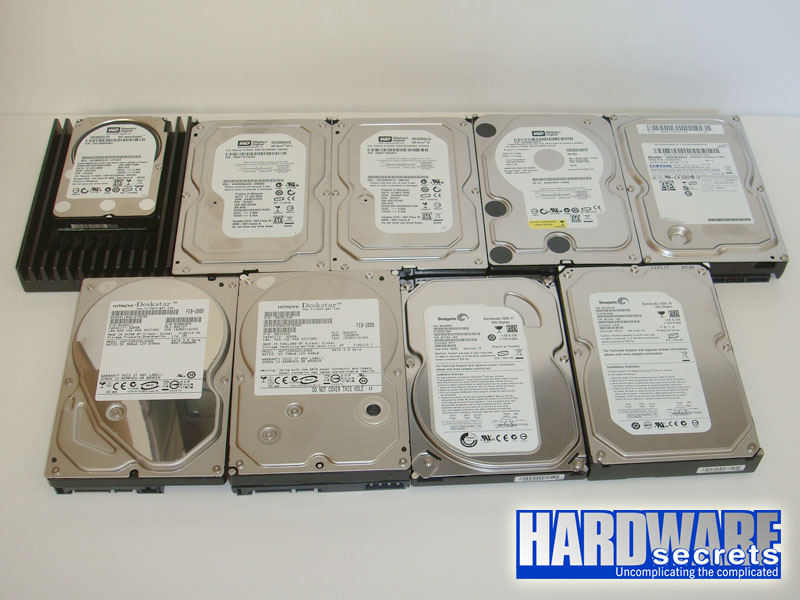
Figure 1: The tested hard disk drives.
We tried to include on this review all 320 GB hard disk drives we could find on the US market. Below you can see a table comparing the main specs for all nine drives included in our round-up. Eight of them rotate at 7,200 rpm – the exception is Western Digital VelociRaptor, which is a 10,000 rpm model – and provide only a SATA power connector, except Hitachi Deskstar T7K500, which was the only model also providing a standard 4-pin peripheral power connector. VelociRaptor is also the only disk that doesn’t have a nominal capacity of 320 GB but 300 GB. Since this disk is supposedly the fastest hard disk drive around, we decided to include it on this round-up. Speaking of which, we have already posted an individual review for Western Digital VelociRaptor, where we compared its performance against two Seagate Barracuda 7200.10 160 GB in RAID0.
All 320 GB models we tested have a real capacity of 298.09 GB (625,142,448 sectors), with VelociRaptor 300 GB having a real capacity of 279.46 GB (586,072,368 sectors). As you may be aware, the capacity advertised by hard disk drive manufacturers isn’t the real drive capacity. Read our Hard Disk Drives Capacity Limits tutorial for further information on this subject.
The prices we researched at Newegg.com on the day we published this review, except for the Samsung model, which was researched at Tigerdirect.com as Newegg.com didn’t carry this model. Most drives can be found on the same price range (USD 65 – USD 70), which the exception of the Hitachi models, which are cheaper, and Western Digital R2 – which is targeted to enterprise solutions and theoretically providing a higher transfer rate, plus higher reliability – and Western Digital VelociRaptor, which is was more expensive than the other models, since it is a high-end drive rotating at 10,000 rpm. Of course during this round-up we will see if it is really worthwhile paying high bucks for this drive.
As you can see most models have 16 MB buffer, but we also included one model with 8 MB buffer. So we will be able if the larger buffer size really increases the drive’s performance. The comparison between Western Digital Caviar SE and SE16 should be really interesting, as they are identical with the only difference being the size of the buffer.
| Manufacturer | Model | Model # | Buffer |
| Hitachi | Deskstar P7K500 | HDP725032GLA360 | 16 MB |
| Hitachi | Deskstar T7K500 | HDT725032VLA360 | 16 MB |
| Samsung | Spinpoint F1 | HD322HJ | 16 MB |
| Seagate | Barracuda 7200.10 | ST3320620AS | 16 MB |
| Seagate | Barracuda 7200.11 | ST3320613AS | 16 MB |
| Western Digital | Caviar SE | WD3200AAJS | 8 MB |
| Western Digital | Caviar SE16 | WD3200AAKS | 16 MB |
| Western Digital | RE2 | WD3201ABYS | 16 MB |
| Western Digital | VelociRaptor | WD3000GLFS | 16 MB |
| Manufacturer | Model | Model # | Price |
| Hitachi | Deskstar P7K500 | HDP725032GLA360 | USD 49.99 |
| Hitachi | Deskstar T7K500 | HDT725032VLA360 | USD 59.99 |
| Samsung | Spinpoint F1 | HD322HJ | USD 69.99 |
| Seagate | Barracuda 7200.10 | ST3320620AS | USD 69.99 |
| Seagate | Barracuda 7200.11 | ST3320613AS | USD 69.99 |
| Western Digital | Caviar SE | WD3200AAJS | USD 64.99 |
| Western Digital | Caviar SE16 | WD3200AAKS | USD 69.99 |
| Western Digital | RE2 | WD3201ABYS | USD 84.99 |
| Western Digital | VelociRaptor | WD3000GLFS | USD 289.99 |
Seagate Barracuda 7200.10 came with a SATA-150/SATA-300 jumper (this didn’t happen with Barracuda 7200.11). This jumper must be removed in order for the drive to work at SATA-300, otherwise it will work as a SATA-150 device. Of course we removed this jumper. For more information on this subject, read our Everything You Need to Know About Serial ATA tutorial.
During our tests we used the configuration listed below and the only variable component between each benchmarking session was the hard disk drive being tested.
Hardware Configuration
- CPU: Core 2 Duo E6600
- Motherboard: ASUS P5K-E/WiFi-AP (1013 BIOS)
- Memory: 2 GB Corsair Dominator TWIN2X2048-8500C5D (DDR2-1066/PC2-8500 with 5-5-5-15 timings), configured at 1,066 MHz
- Video Card: Gigabyte GeForce 8800 GTS 320 MB
- Video resolution: 1440×900 75 Hz
- Video Monitor: Samsung Syncmaster 932BW
- Power Supply: OCZ ProXStream 1000 W
- CPU Cooler: Thermaltake TMG i1
- Optical Drive: LG GSA-H54N
Software Configuration
- Windows XP Professional using NTFS file system
- Service Pack 3
- Intel Inf driver version: 9.0.0.1008
- NVIDIA video driver version: 175.19
Benchmarking Software
We adopted a 3% error margin. So, performance differences below 3% cannot be considered meaningful. In other words, products where the performance difference is below 3% must be considered as havi
ng similar performance.
As you could see in the previous page, we measured performance using three different programs, DiskSpeed32, HD Tach and HD Tune. On this page we will analyze the results provided by DiskSpeed32, while in the next pages we will discuss the results brought by the other two programs.
First, let’s take a look at the burst transfer rate results.
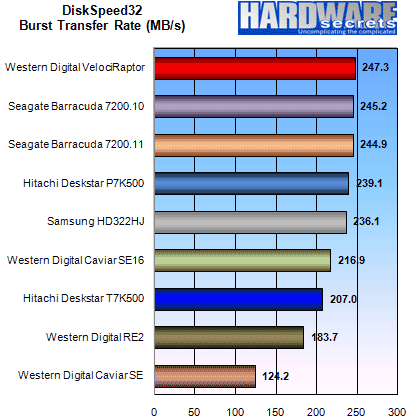
Here Western Digital VelociRaptor, Seagate Barracuda 7200.10, Seagate Barracuda 7200.11, Hitachi Deskstar P7K500 and Samsung HD322HJ achieved the same performance level. These drives were, on average, 12% faster than Western Digital Caviar SE16, 17% faster than Hitachi Deskstar T7K500, 32% faster than Western Digital RE2 and 95% faster than Western Digital Caviar SE.
Having a bigger buffer made a difference for Western Digital Caviar SE, where the SE16 (16 MB) model was 74.64% faster than the regular SE model (8 MB).
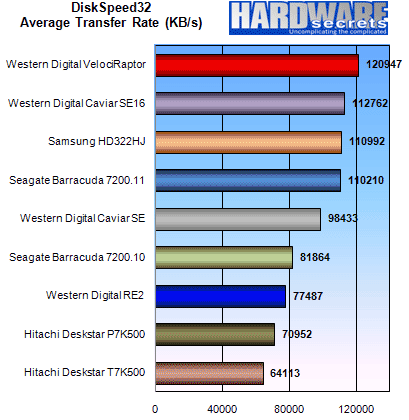
But the most import result is the average transfer rate. Here Western Digital VelociRaptor was the fastest disk, which was expected. Western Digital Caviar SE16, Samsung HD322HJ and Seagate Barracuda 7200.11 achieved the same performance level and they were only 7% and 9% slower than VelociRaptor, a disk that is four times more expensive than these models.
These three disks were, on average, 13% faster than Western Digital Caviar SE, 36% faster than Seagate Barracuda 7200.10, 44% faster than Western Digital RE2, 57% faster than Hitachi Deskstar P7K500 and 74% faster than Hitachi Deskstar T7K500.

The maximum transfer rate is achieved when the disk is reading data stored on its outer most tracks. Here the two hard drives from Hitachi achieved the highest transfer rate but their average transfer rate was lower than the one achieved by other disks because they also achieved the lowest minimum transfer rate, as we will discuss in just a bit.
Western Digital VelociRaptor, Western Digital Caviar SE16, Samsung HD322HJ and Seagate Barracuda 7200.11 achieved the same performance here, while Western Digital Caviar SE, Seagate Barracuda 7200.10 and Western Digital RE2 achieved the same performance level among themselves. The disks from the first group were, on average, 40% faster than the disks from the second group. Hitachi Deskstar T7K500 was 11% faster than the disks from the first group, while Hitachi Deskstar P7K500 was 23% faster.
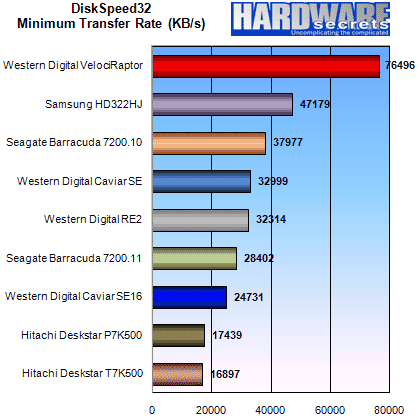
The minimum transfer rate is achieved when the disk is reading data stored on its inner most tracks. As you can see, the difference between the maximum and the minimum transfer rate is huge, and that explains why is so important to defragment your hard disk drive from time to time, to ensure that data is mostly stored on the disk’s outer tracks, which provide a higher transfer rate.
Here is where you can better understand the difference between VelociRaptor and the other hard disk drives. While its burst, average and maximum transfer rates may be close to the rates achieved by other drives, its minimum transfer rate is far higher than any other drive included in our comparison. This means that VelociRaptor achieves a good performance even when reading the inner-most tracks from the hard disk drives, what doesn’t happen with other models.
Just to give you some numbers, VelociRaptor’s minimum transfer rate was 62% higher than Samsung HD322HJ’s, 101% higher than Seagate Barracuda 7200.10’s, 169% higher than Seagate Barracuda 7200.11’s, 132% higher than Western Digital Caviar SE’s and 209% higher than Western Digital Caviar SE16’s.
The hard drives from Hitachi achieved the lowest transfer rate here and this explains why even though they achieved a very high maximum transfer rate their average transfer rate wasn’t that great.
If you are interested, you can find below the read curves plotted by DiskSpeed32 for each hard disk drive tested.
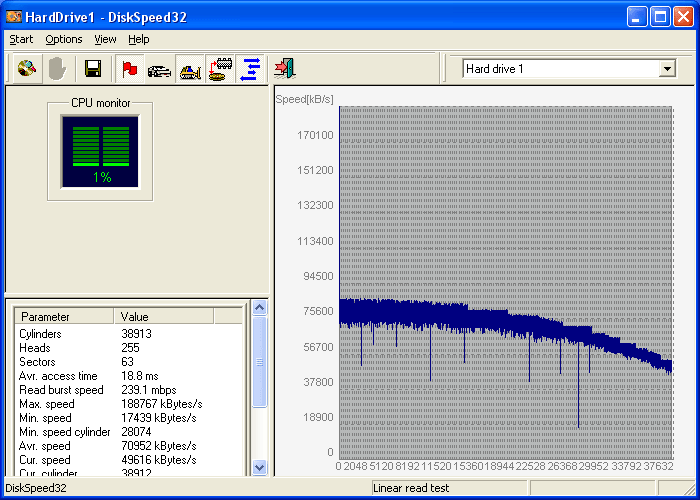
Hitachi Deskstar P7K500
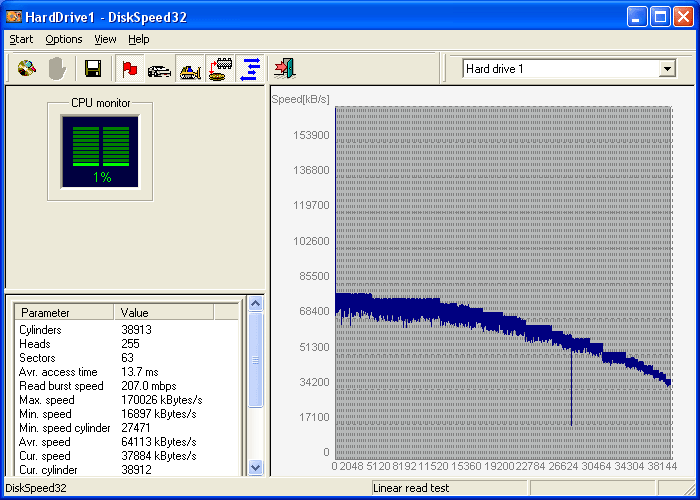
Hitachi Deskstar T7K500
Samsung Spinpoint F1
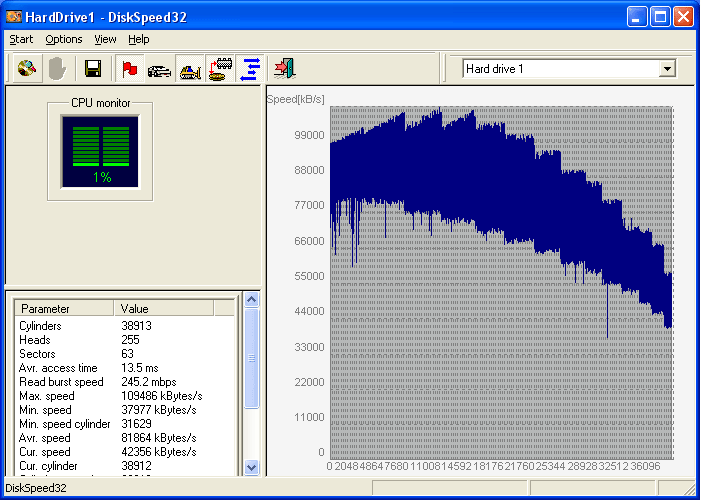
Seagate Barracuda 7200.10
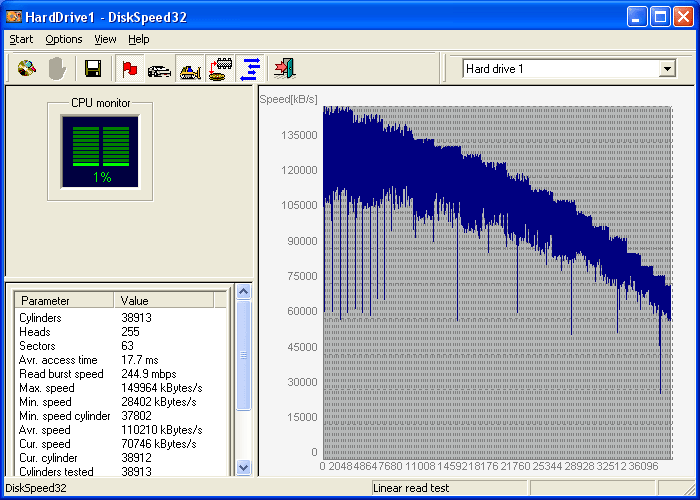
Seagate Barracuda 7200.11
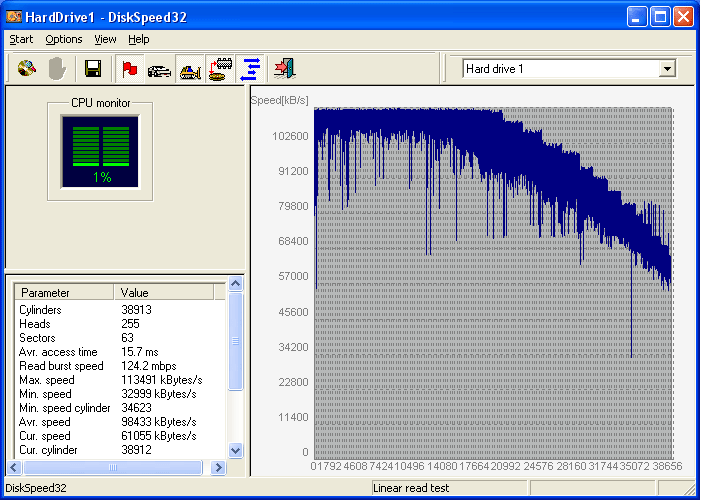
Western Digital Caviar SE
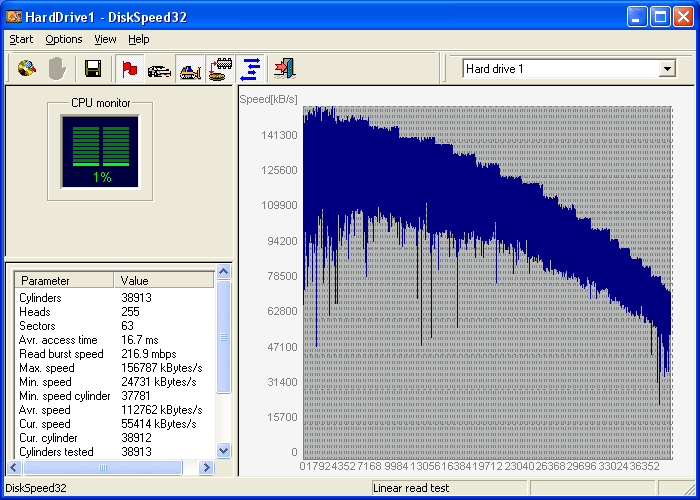
Western Digital Caviar SE16
Western Digital RE2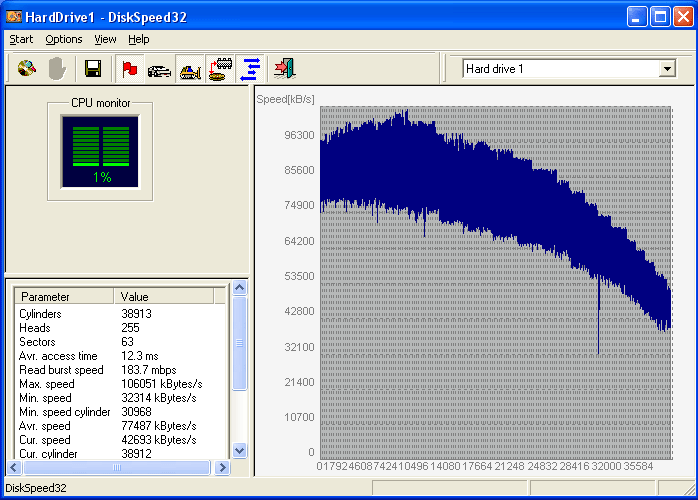
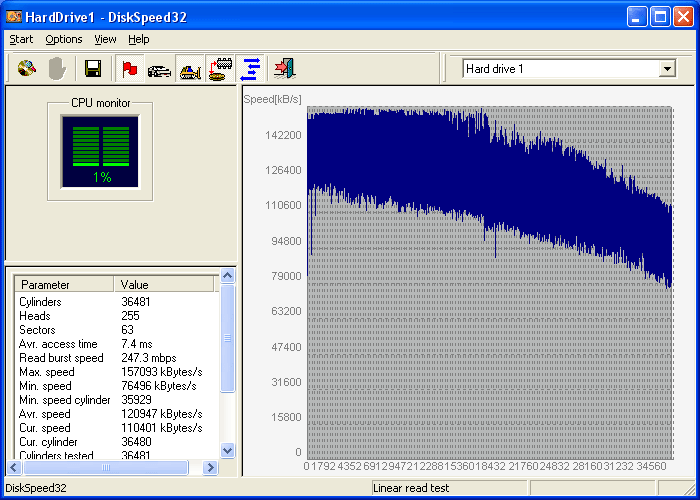
Western Digital VelociRaptor
HD Tach provides only two results, the burst transfer rate and the average transfer rate. We ran the “long bench” test from this program.
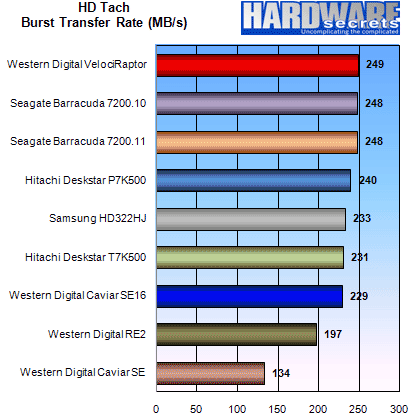
Here Western Digital VelociRaptor, Seagate Barracuda 7200.10, Seagate Barracuda 7200.11 and Hitachi Deskstar P7K500 achieved the same burst transfer rate, like it happened on DiskSpeed32. They were, on average, 7% faster than Samsung HD322HJ, Hitachi Deskstar T7K500 and Western Digital Caviar SE16 – which achieved a similar burst transfer rate –, 25% faster than Western Digital Caviar RE2 and 84% faster than Western Digital Caviar SE.
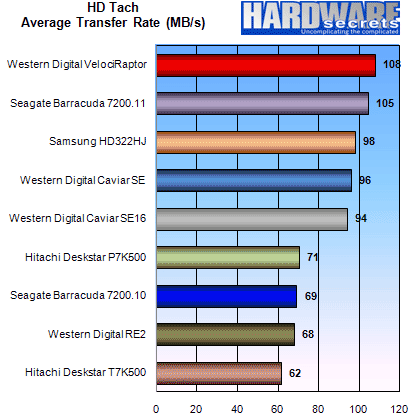
The average transfer rate measured by HD Tach put Western Digital VelociRaptor and Seagate Barracuda 7200.11 on the same performance level. These two disks were, on average, 11% faster than Samsung HD322HJ, Western Digital Caviar SE and Western Digital Caviar SE16 – which achieved the same performance level –, 54% faster than Hitachi Deskstar P7K500, Seagate Barracuda 7200.10 and Western Digital RE2 – which achieved the same performance level – and 72% faster than Hitachi Deskstar T7K500.
If you are interested, you can find below the read curves plotted by HD Tach for each hard disk drive tested.


Hitachi Deskstar P7K500
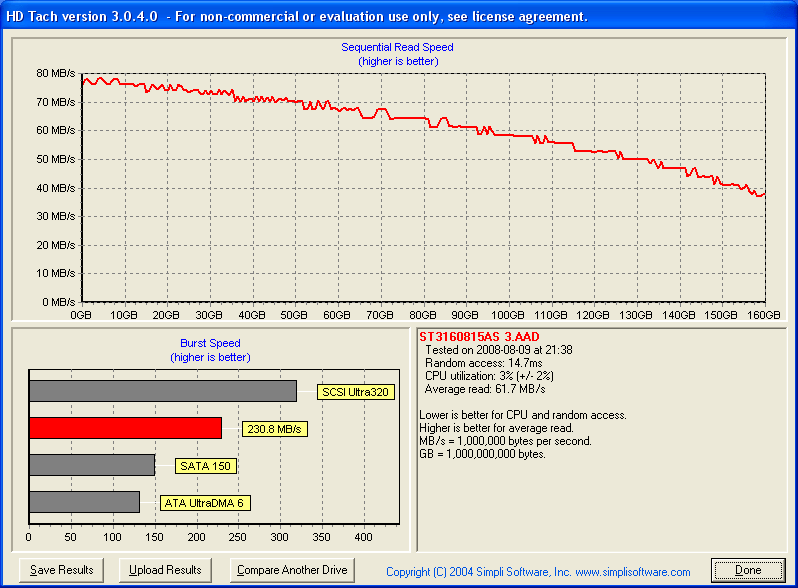

Hitachi Deskstar T7K500
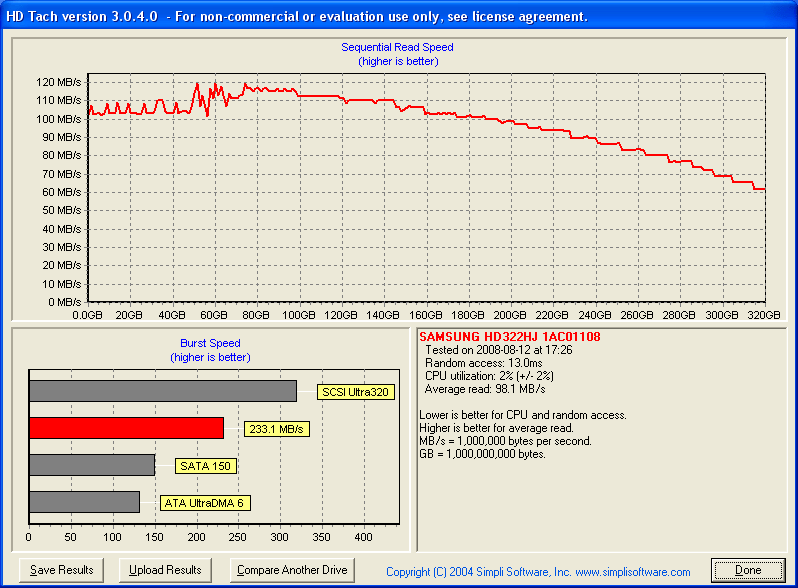

Samsung Spinpoint F1
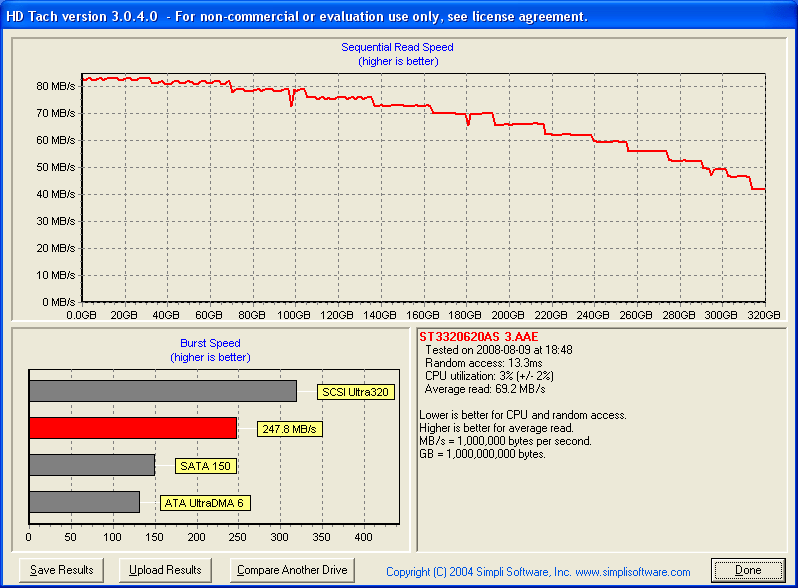

Seagate Barracuda 7200.10
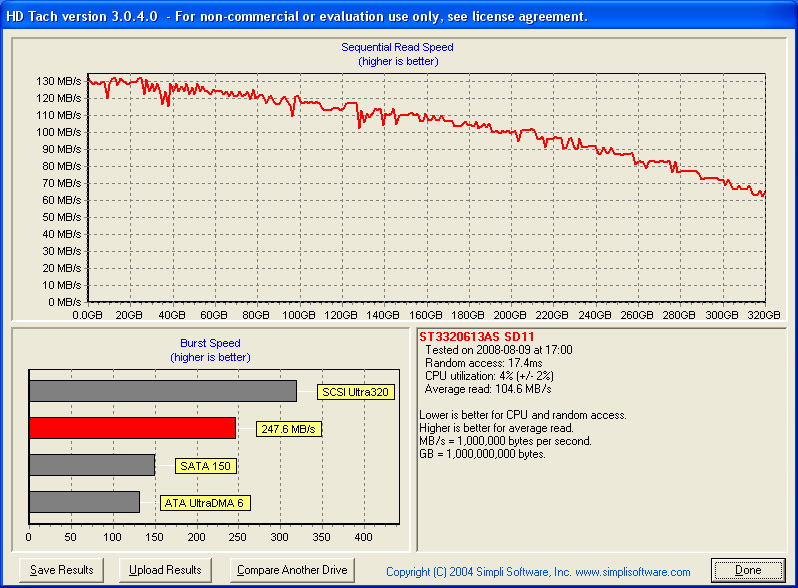

Seagate Barracuda 7200.11
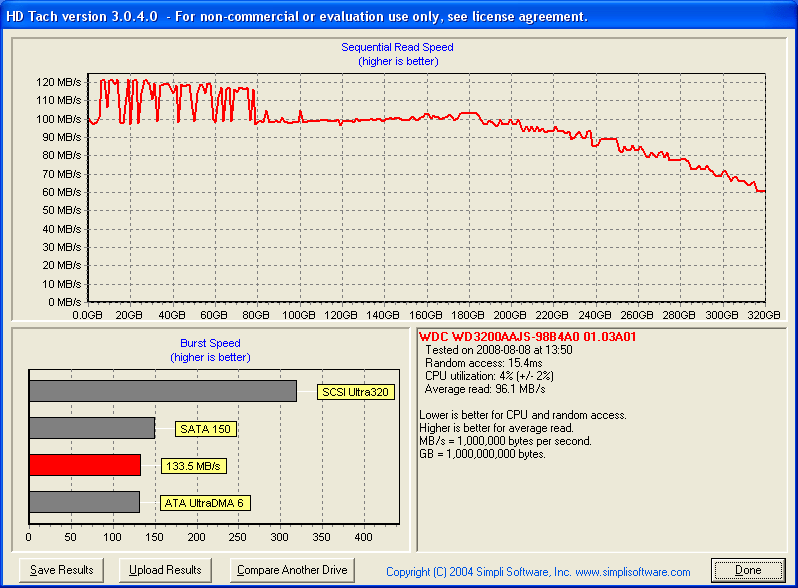

Western Digital Caviar SE
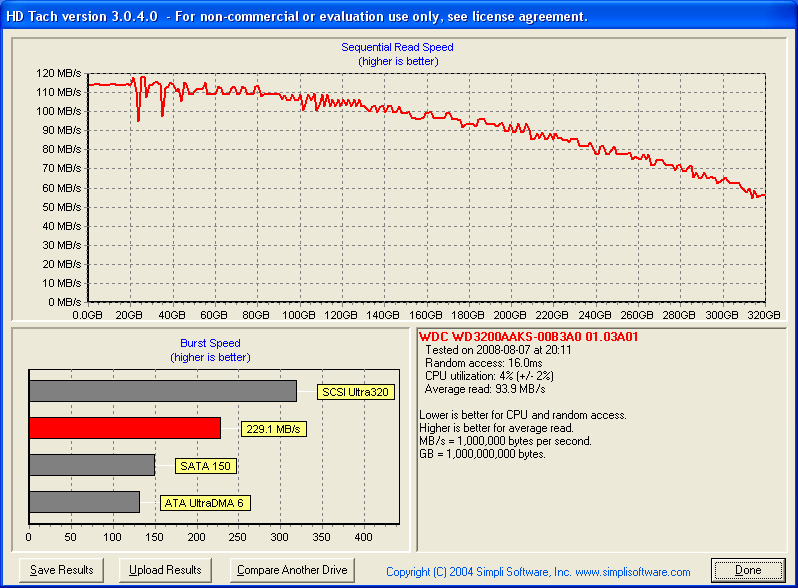

Western Digital Caviar SE16
Western Digital RE2
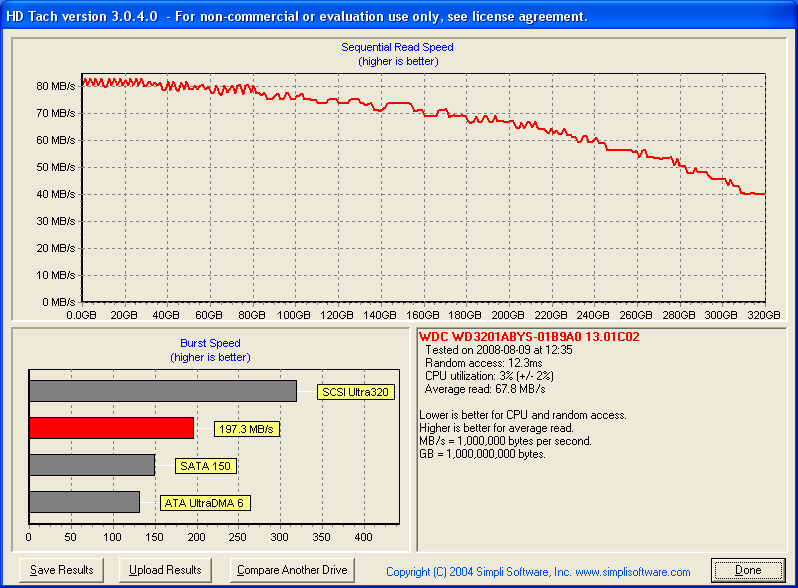

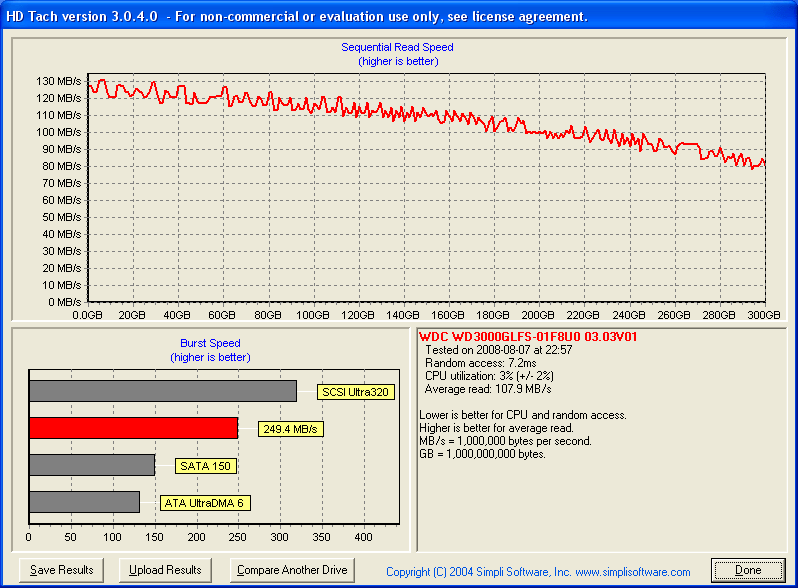

Western Digital VelociRaptor
Now we have the results provided by HD Tune program.
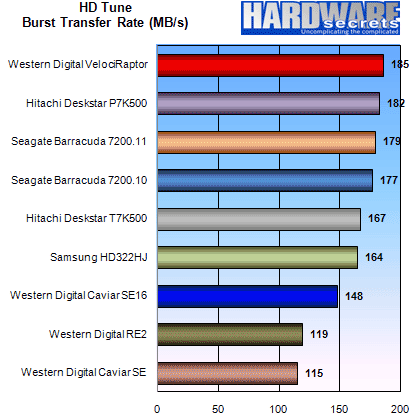

Here Western Digital VelociRaptor and Hitachi Deskstar P7K500 achieved a similar burst transfer rate, with Seagate Barracuda 7200.11 and Seagate Barracuda 7200.10 being very close. These disks were, on average, 9% faster than Hitachi Deskstar T7K500 and Samsung HD322HJ – which achieved the same performance level –, 22% faster than Western Digital Caviar SE16, and 55% faster than Western Digital RE2 and Western Digital Caviar SE, which achieved the same performance level.
Here Western Digital SE16 (16 MB buffer) was 29% faster than Western Digital SE (8 MB buffer).



The most important figure for most people is the average transfer rate. Here Western Digital VelociRaptor and Seagate Barracuda 7200.11 achieved the same performance level. They were, on average, 10% faster than Samsung HD322HJ, Western Digital Caviar SE and Western Digital Caviar SE16 – which achieved the same performance level –, 53% faster than Hitachi Deskstar P7K500, Seagate Barracuda 7200.10 and Western Digital RE2, and 67% faster than Hitachi Deskstar T7K500.
Samsung HD322HJ, Western Digital Caviar SE and Western Digital Caviar SE16 were, on average, 39% faster than Hitachi Deskstar P7K500, Seagate Barracuda 7200.10 and Western Digital RE2.
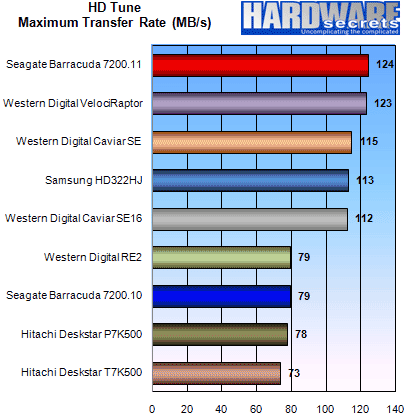

As explained before, the maximum transfer rate is achieved when the hard drive is reading data from its outer-most tracks.
Here we have different results from what we’ve seen on DiskSpeed32. Seagate Barracuda 7200.11 and Western Digital VelociRaptor achieved the same performance level, which was, on average, 9% higher than the one achieved by Western Digital Caviar SE, Samsung HD322HJ and Western Digital Caviar SE16, 57% higher than the
one achieved by Western Digital RE2, Seagate Barracuda 7200.10 and Hitachi Deskstar P7K500 and 68% higher than the one achieved by Hitachi Deskstar T7K500.
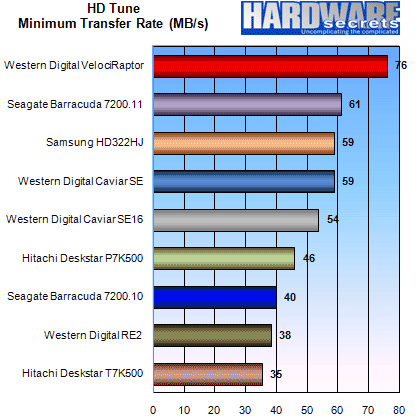

As explained before, the minimum transfer rate is achieved when the hard drive is reading data from its inner-most tracks.
The results here confirmed what we’ve seen on DiskSpeed32: Western Digital VelociRaptor is the hard disk drive with the highest minimum transfer rate, meaning that it will still deliver a decent performance even on worst-case scenario.
Here Seagate Barracuda 7200.11, Samsung HD322HJ and Western Digital Caviar SE achieved the same performance level.
If you are interested, you can find below the read curves plotted by HD Tune for each hard disk drive tested.
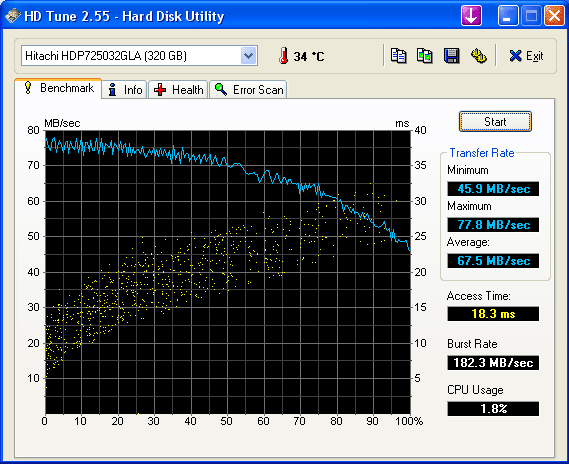

Hitachi Deskstar P7K500
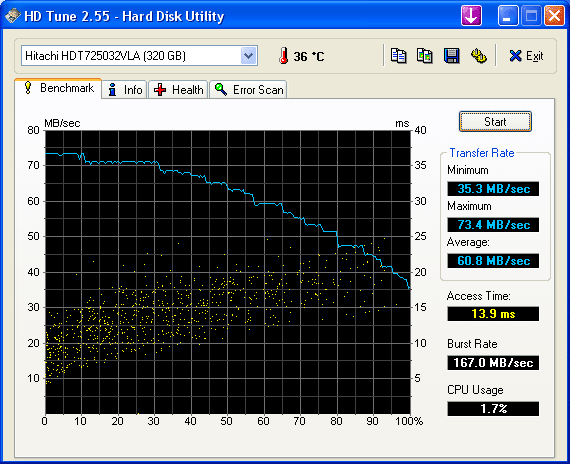

Hitachi Deskstar T7K500
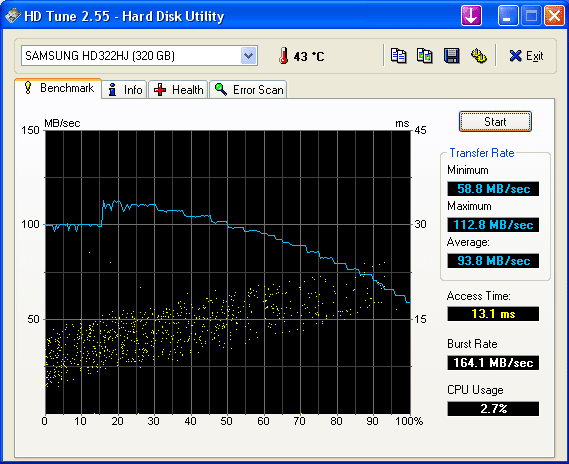

Samsung Spinpoint F1
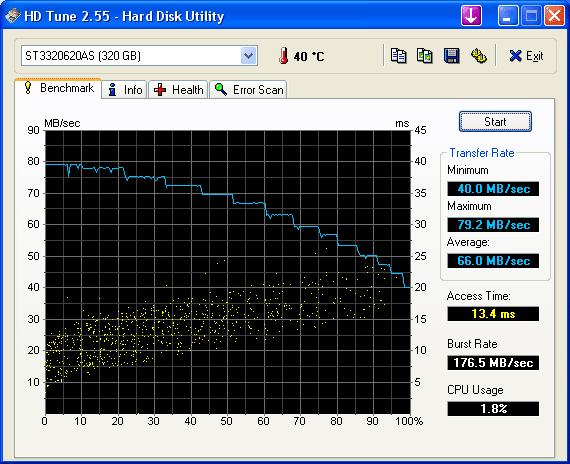

Seagate Barracuda 7200.10
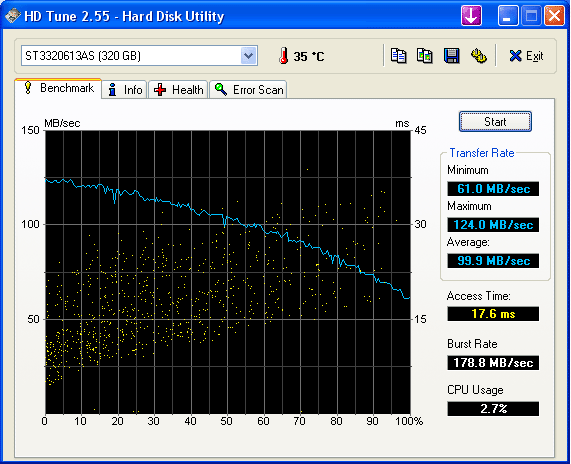

Seagate Barracuda 7200.11
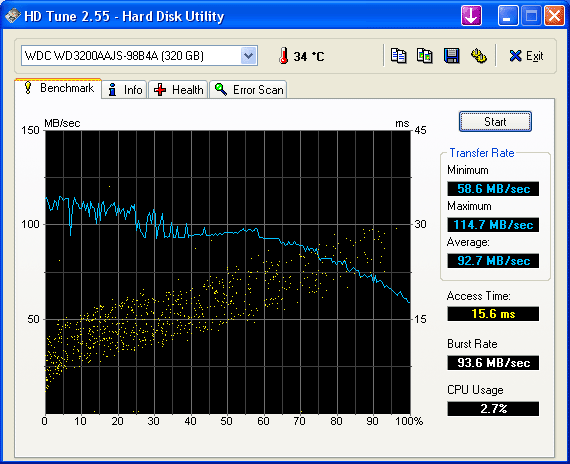

Western Digital Caviar SE
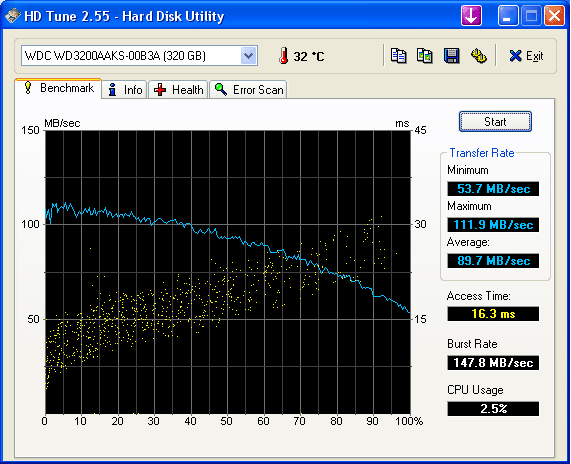

Western Digital Caviar SE16
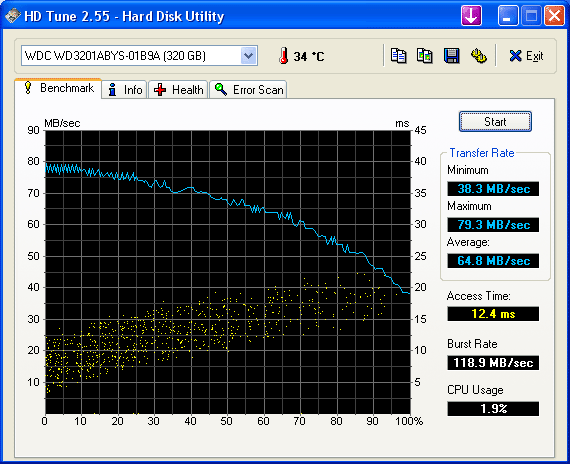

Western Digital RE2
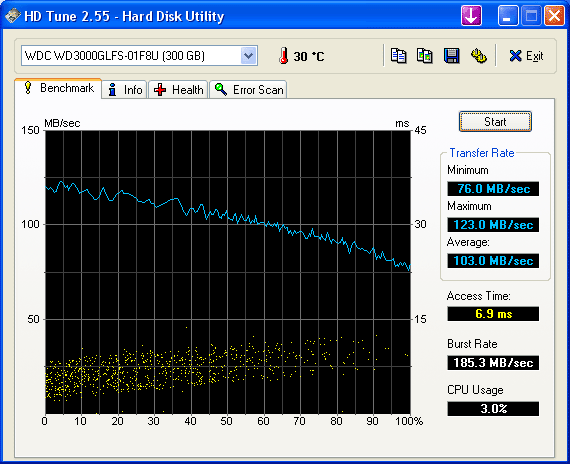

Western Digital VelociRaptor
Access time is another important measurement. It measures the time the hard disk drive delays to start delivering data after the computer has asked a given data. It is measured in the order of milliseconds (ms, which is equal to 0.001 s) and the lower this value, the better.
The results presented by the three programs we used were very similar, so we made arithmetic averages with the collected results and present them on the chart below.
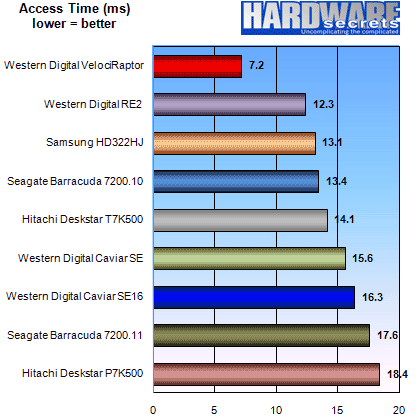

The highlight here was Western Digital VelociRaptor, which had an average access time of only 7.2 ms, being 45% faster than Samsung HD322HJ, 47% faster than Seagate Barracuda 7200.10, 56% faster than Western Digital Caviar SE16 and 59% faster than Seagate Barracuda 7200.11.
We found out a lot of interesting information about the 320 GB hard disk drives available on the market today. In summary, not all 320 GB drives are equal.
VelociRaptor from Western Digital is the fastest hard disk drive around on this capacity range. The main differences between this disk and other disks are the far lower access time and the far higher minimum transfer rate, meaning that this disk will keep a decent performance while reading its inner-most tracks, thing that doesn’t happen with other units. The problem, however, is its price: it is four times more expensive than a mainstream 320 GB drive.
Some mainstream drives were able to keep a performance very close to VelociRaptor, in particular Seagate Barracuda 7200.11. We were surprised to see this drive being sold by the same price as Barracuda 7200.10, even though it provides a far higher performance. Seagate Barracuda 7200.11 is our recommendation for the average user that is looking for a 320 GB hard disk drive. Other two good options are Western Digital Caviar SE16 and Samsung HD322HJ, even though these two drives achieved a performance a little lower than Seagate Barracuda 7200.11 in some tests.
All other 320 GB hard disk drives should be avoided.
Here is a breakdown of what we found out about each hard drive included in our round-up:
- Hitachi Deskstar P7K500 (HDP725032GLA360): Achieved a performance far lower than the other hard disk drives included in our round-up. It is cheaper than the other reviewed drives and, believe, there is a reason for that. The price difference does not compensate its lower performance. Don’t buy.
- Hitachi Deskstar T7K500 (HDT725032VLA360): The worst hard disk drive from our round-up. Inexplicably it is more expensive than the other model from Hitachi we included in our comparison. Don’t buy. If you have one, replace it.
- Samsung Spinpoint F1 (HD322HJ): A good mainstream hard disk drive, a good option if you can’t find Barracuda 7200.11.
- Seagate Barracuda 7200.10 (ST3320620AS): Barracuda 7200.11 costs the same thing and presents a higher performance. So, don’t buy Barracuda 7200.10. If you can’t find Barracuda 7200.11, buy Samsung HD322HJ or Western Digital Caviar SE16.
- Seagate Barracuda 7200.11 (ST3320613AS): This is the drive we recommend. It provides a burst and average transfer rates comparable to Western Digital VelociRaptor, but costing only ¼ of the price. As mentioned, if you can’t find this drive buy Samsung HD322HJ or Western Digital Caviar SE16 instead.
- Western Digital Caviar SE (WD3200AAJS): It is a little bit cheaper than the other
drives we are recommending, but frankly spend a little bit more to have a drive with a better performance. - Western Digital Caviar SE16 (WD3200AAKS): A good mainstream hard disk drive, a good option if you can’t find Barracuda 7200.11.
- Western Digital RE2 (WD3201ABYS): Lousy performance. Don’t buy.
- Western Digital VelociRaptor (WD3000GLFS): Even though it is really the fastest hard disk drive around, we don’t think paying four times more is a good deal for the average user, especially when you can achieve the same burst and average transfer rates with a Seagate Barracuda 7200.11. Of course for the extreme gamer with bottomless pockets building the ultimate gaming machine two VelociRaptors in RAID0 will probably be his best choice, even though you can buy eight Barracuda 7200.11 drives with the same amount of money.

Leave a Reply